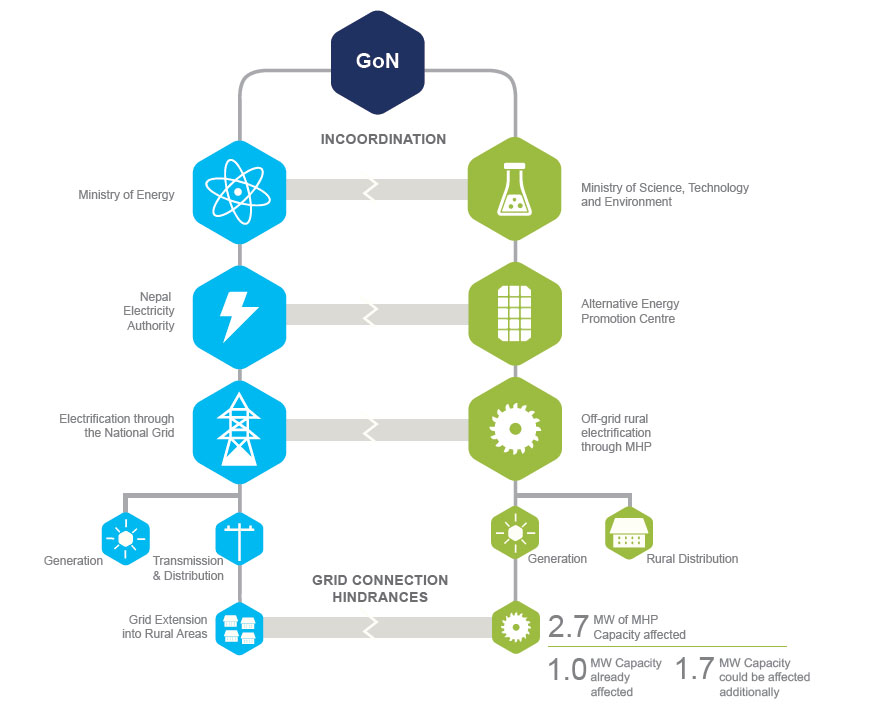News
- By 2014, more than 1,000 MHPs with total generation capacity of 22 MW had been developed, providing off-grid electricity access to 20 % of the population.
- However, significant achievements in the micro hydropower sector have also brought about various challenges like MHP-national grid interface
Micro hydropower plants (MHPs), starting as small turbine mills in the hills of Nepal in the early 1960s, have slowly increased in number and capacity to become a major source of off-grid electricity in rural Nepal. By 2014, more than 1,000 MHPs with total generation capacity of 22 MW had been developed, providing off-grid electricity access to 20 % of the population.
In a country where 30 percent of the population have no access to electricity and the rest have to bear with load shedding of up to 12 hours per day, development of such renewable energy technology, both on-grid and off-grid, has become crucial to increase energy access. Micro hydropower plants contribute substantially to improve the rural economy and help in overall development and poverty reduction.
The future of Micro Hydropower – Challenges
By 2017, the total generation capacity of MHPs is predicted to be 50 MW. However, significant achievements in the micro hydropower sector have also brought about various challenges that require new approaches.
One such major challenge is to address the MHP–national grid interface. As the state-owned electricity utility, Nepal Electricity Authority (NEA), extends its grid to rural areas, many MHPs become redundant if they cannot be grid-connected. According to a preliminary estimate by the Alternative Energy Promotion Centre (AEPC), the central government body to promote alternative energy, 90 MHPs with net capacity of 2.7 MW have been affected by grid extension and this number is steadily increasing. If the right policies for connecting MHPs to the grid are not in place, these plants will be forced to shut down and then abandoned.
To understand the barriers and opportunities for scaling up micro hydropower projects and to provide recommendations on how such scaling up can be achieved, the World Bank conducted a study on “Scaling up Electricity Access through Mini and Micro Hydropower Applications – A strategic stock-taking and developing a future roadmap” with the financial support provided by the
Asia Sustainable and Alternative Energy Program (ASTAE).
A Roadmap for the future of Micro Hydropower
The study conducts analyses on issues pertaining to the micro hydropower sector and provides policy and operational recommendations to stakeholders including the government and development partners. Some of the key findings and recommendations of the report as follows:-
1) Prioritize MHP as the most cost efficient off-grid rural electrification method
For delivering the same level of services by a typical MHP in rural Nepal, other methods (such as diesel and solar) are more than twice as expensive. Therefore, MHPs should be the first choice to deliver off grid electrification where they are technically feasible.
2) Continue subsidy support for MHP to ensure delivery of economic benefits to rural area
Although rural electrification through MHP returns economic benefits approximately three times larger than the investment and operating costs, MHPs are not financially viable in the conventional sense. Therefore, subsidy should be continued to support the MHPs development but smarter way for scaling up.
3) Scale-up MHP by aggregate demand and optimize site potential
Smaller plants are usually less viable and cost more to set up than larger plants. The focus of planning for MHPs should be changed from merely meeting the current power requirements of the community to optimize site potential by aggregating demand.
4) Build grid-compatible MHPs
Once the national grid arrives in an MHP’s service area, grid connection is unequivocally the next step forward. Therefore, new standalone MHPs, especially MHPs larger than 50 kW, should be designed to be grid compatible.
5) Give preference to connect MHPs to the national grid
NEA should give preference to drawing power from MHPs by connecting them to the national grid, since delivering electricity through an MHP is more economical than delivering electricity through NEA’s grid to rural areas.
6) Establish innovative financing instruments to finance grid connection of MHPs
AEPC should facilitate access to low-cost loans (as well as risk guarantee) rather than providing capital subsidy to the rural communities (or the MHP owners) for grid connections of MHPs.
7) Harmonize rural electrification programs by effective coordination between NEA and AEPC
Since the government provides subsidy support both to the community based rural electrification program for extending the national grid to rural areas through NEA and to MHPs development through AEPC, it is critical for these two programs to be harmonized so that the subsidies are utilized optimally and the MHP-grid interface issues are resolved in a planned way. Most importantly, NEA and AEPC should collaborate to prepare a national rural electrification master plan.

